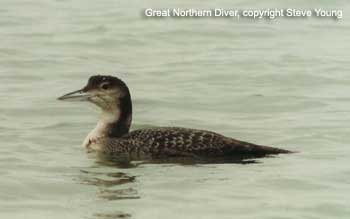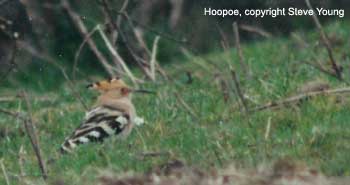Some ten years ago the Cheshire and Wirral Ornithological Society (
www.cawos.org) decided to open a competition to all their members. The rules were simple - record as many bird species as possible within the boundaries of Cheshire and Wirral during the course of the calendar year 1995. As I had done a big National year-list in 1994, I saw this as a great way to find out what I was missing closer to home, and decided to accept the challenge. Here is an account of that fantastic year in a great county for birding.
The year began in fine style with the long-staying Welsh
Red Kite putting on an aerial display over the Old Deer Enclosure in Tatton Park near Knutsford. This bird had been ringed and wing-tagged in the Upper Twyi Valley in mid-Wales in June 1993. It arrived in the Knutsford area as a juvenile in November 1993, and remained until April 1995. Contributing to it's long stay was a constant supply of food in the extensive rabbit warrens and an offal pit in Tatton Park. At times in the Park, it felt like being in a Welsh valley, with up to 7 species of raptor being seen, including the Kite and multiple counts of
Common Buzzards.
At the time, Budworth Mere in Marbury Country Park near Northwich was my local patch. Extended patch visits here produced good views of the elusive
Eurasian Bittern, which was over-wintering in the Coward Memorial reed-bed. Despite the fairly small size of the reed-bed, the birds' camouflaged plumage, and often cryptic and shy nature made it very difficult to spot at times.
Also during the early winter period, much time was spent birding on the Wirral peninsula. Highlights here included a
Black Redstart - a great bird to see in the county - on the North Wirral coast. This bird had chosen the gardens and houses on Leasowe Common as a temporary winter haven, and we watched it chasing insects in the pockets of warm air trapped inside a garden shed!
At the foot of the Wirral, nearctic species appeared amongst the large numbers of wildfowl over-wintering at Inner Marsh Farm RSPB Reserve by the Dee Estuary. A handsome drake
American Wigeon amongst c2,000
Eurasian Wigeon in February, was soon followed by a white-phase
Snow Goose which arrived with 2
Pink-footed Geese in early March, and departed in mid-April. March turned out to be a sensational month, starting with a confiding 1st-winter
Great-northern Diver on Watch Lane Flash, Sandbach - the first ever diver of any species at Sandbach Flashes. It was harrassed by some disgracefully behaved local fishermen but survived to stay a week from 3rd-10th, and was seen nearby on 11th. Perhaps the same bird, on it's way back to the coast, was on West Kirby Marine Lake on the Wirral later in the month.
 |
| Great Northern Diver, Kirby Marine Lake, March 1995, copyright Steve Young |
A colourful female
Ruddy Shelduck which briefly visited Woolston Eyes NR near Warrington on 24th March was perhaps the same bird as the one on Marbury No1 tank in late April, where it was a local patch tick for me. This was followed by a colour-ringed male on the Dee Estuary at Heswall salt-marsh in May. These were part of around 10 birds seen in the county during the year including at least 5 on the Mersey.
At the end of March, focus again attentioned on the Wirral. A very pretty
Shore Lark had been found at Neston on the Dee Estuary. This bird could be elusive and spend long periods out on inaccessible areas of the marsh, but I was lucky to see it feeding in the Old Quay car park, just a few yards away, where I could savour every plumage detail. This, coupled with a 'pastel lavender above and peach flush below' summer-plumaged
Water Pipit at the nearby stream made for some excellent birding.
Further exciting news came when a
Hoopoe was discovered at Thurstaston on the Wirral Way. In the early Spring sun-shine this exotic-looking and confiding visitor gave great views as it wandered around a chicken coop!
 |
| Hoopoe, Thurstaston CP, March 1995, copyright Steve Young |
Paradoxically, coastal winter ducks appeared inland at Chelford Sand Quarries in mid-Cheshire, with an adult drake
Greater Scaup at Farmwood Pool for most of the Spring, and an immature drake
Long-tailed Duck on Catchpenny Pool in May.
I spent a fair amount of time in the Spring in the eastern hills of the county, searching tracts of moorland, and upland forests, woods and streams for 'eastern' specialities such as
Ring Ouzel, Red Grouse, Common Redstart and
White-throated Dipper. During these birding expeditions I had some interesting sightings - Cheshire's equal earliest ever
Pied Flycatcher - a singing male at Tegg's Nose CP near Macclesfield on April 9th, a
Eurasian Woodcock sat out in the open on a dry-stone wall in the daylight near Wildboarclough, and a singing male
Common Stonechat by Danebower Quarry.
Whinchats started to pass through, and I managed to see 2 of these fairly scarce migrants in a weekend in late April. A singing male (in the same area as a singing
Lesser Whitethroat) on the outskirts of Chester was a county life-tick and another was at Burton Point the next day, making up a slightly unlikely duo with a late
Short-eared Owl. The southerly winds bringing the migrants in also brought the hoped for 'mega' - a
Short-toed Lark... only the 2nd ever for Cheshire and Wirral. It was found on Friday May 5th in fields to the west of Leasowe Lighthouse on the North Wirral shore. To the relief of the weekenders (myself included) it remained the next day, when I had superb views on a beautiful, warm Spring morning as it fed in an open field. Also here was a
Grasshopper Warbler which 'reeled' away from a prominent twig nearby on the Common, to the delight of the Lark twitchers. Other features of the Spring were good numbers of
Garganey and
Mediterranean Gulls, especially at Inner Marsh Farm RSPB Reserve. An unexpected sight at the end of the Spring was a
Northern Fulmar 'shearing' inland over Burton Marsh on 27th May.
On 5th June an
Osprey was seen briefly in Tatton Park before going to roost. I arrived early the next morning but it had departed close after dawn. After a 7 hour stake-out I was most pleased to see this magnificent raptor on its' third, brief and final appearance in the Park. I was not so lucky a few days later in Tatton Park as I dipped on a Golden Oriole in Dog Wood.
Early July saw Chris Done and I spending time in the Farndon area near Chester searching for the two specialities of the area -
Quail and
Turtle Dove. The Doves were seen, but the Quail were only heard. During the summer, many hours were spent gazing across marshes looking for elegant white herons, which were visiting the county from the near continent. When we weren't getting confused by distant
Mute Swans, gulls or plastic bags in the heat-haze, we were looking across the Dee Estuary and admiring Cheshire and Wirrals' first-ever
Great White Egret, or at Frodsham Marsh No6 bed appreciating the long-staying
Spoonbill and 3
Little Egrets. At this last site on July 31st I joined a frustrated crowd dipping the short-staying Gull-billed Tern.
In early August a
Pectoral Sandpiper appeared on Elton Hall Flash, Sandbach. By the time I arrived to see the bird, extra eyes at the site had picked up a
Spotted Crake feeding around the juncus close to the viewing point by the road. August finished with a
Shag - another excellent county bird - which I saw flying over the mouth of the River Mersey off New Brighton with a
Cormorant for convenient comparison, and an eclipse drake
Garganey which I found on the spit at Budworth Mere - a great patch find.
Anyone who knows the county is aware that Frodsham Marsh can be one of the best sites in the country for wader watching, especially the autumn. Although not as well-watched as in its' heyday of the 1970's and 80's the area still provides some very exciting birding, and this autumn was to be no exception. Its' proximity to the River Mersey means that thousands of waders are passing through the area, and during September there were sometimes large, but often erratic, high-tide roosts of wading birds on no4 bed. I spent many hours sifting through the flocks of commoner waders such as
Dunlin, Ringed Plover, Lapwing, Eurasian Golden Plover, Redshank and
Godwits, recording good numbers of scarcer migrants such as
Little Stints and
Curlew Sandpipers. It was on this bed on 12th September that Chris Done and I found a tiny stint with pale green legs, which we watched at c100 yards range roosting on the sun-baked mud with a single Ringed Plover for nearly 2 hours. Chris raced off to a phone-box as soon as we suspected the identification of the bird. To our - and others - chagrin, it flew off before other birders arrived and was not seen during further searches of the area. We were certain the bird was a
Least Sandpiper - a species I had seen a few weeks previously in Sussex and have subsequently seen hundreds of in America. We took as many notes as possible during the excitement of it all, but our 2 observer sighting and description of what would be an extreme rarity was rejected by the BBRC. We took the decision at the time, putting it more down to our descriptions than the actual identity of the bird. A valuable lesson learned and we vowed to improve our description writing if we were ever lucky enough to be in a similar situation again - nb: this was to be soon.
In the autumn, the North Wirral coast-line is also a good place to be and there was lots happening here in mid-late September... ... at a
Melodious Warbler twitch at Red Rocks near Hoylake I had very brief views of the bird, and later in the month a surreal day watching large numbers of
Leach's Petrels fluttering close inshore past Leasowe Lighthouse on a calm, sunny day finished off with a dip on a Bonelli's Warbler nearby! Later in the month Stuart Naylor and I had brief views of a probable adult
American Golden Plover amongst a flock of
Eurasian Golden Plovers on No4 bed at Frodsham. We suspected it was an American Goldie as it was in a more advanced state of summer-plumage than the other golden plovers, with extensive black blotching on the underparts, had a stonking 'tippex' white eye-stripe and strongly contrasting spangled golden/dark upperparts. Unfortunately, after watching the bird for one or two minutes, a
Peregrine Falcon flew close overhead and all the waders flew off not to return again. We didn't get long enough views to obtain sufficient detail to put a description together - another 'one that got away...'
My luck was to soon change, however, and my frustration turned to joy when I found an eclipse drake
American Wigeon on my birthday, Thursday 5th October, amongst a newly arrived flock of
Eurasian Wigeon and
Northern Pintail on my local patch of Budworth Mere. This must have been a birthday present for all those long hours spent in the field, although this bird was nearly 'one that got away' aswell! When I located the bird it was at long range as it grazed with the other ducks on the grassy field between the spit and the Coward Memorial reed-bed. I suspected its' identity but despite watching the bird for over 4 hours could still not be certain. Luckily, when I next visited the site, on the morning of Sunday 8th October, the bird was feeding c75-100 yards off the boathouse in excellent light. Its' identity was confirmed, we made an acceptable description, and the birds' subtle delights were enjoyed by a steady stream of admirers throughout the day.
More wildfowl followed with 2
Whooper Swans joining the
Bewick's on the Burton Marshes off Denhall Lane, and the multi colour-ringed Scandinavian re-introduction scheme adult
Lesser White-fronted Goose with
Barnacle and
Canada Geese in the south of the county, on fields by Marbury Big Mere near Whitchurch. The Lesser White-fronted Goose had been raised under a semi-feral Barnacle Goose in Sweden and was supposed to migrate with the Barnacles to the low countries of Europe - which are considered safer wintering grounds than traditional ones - and then return to Sweden to breed. However, this bird got lost in its' first winter and arrived at Aldcliffe Marsh in Lancashire in November 1991, before moving to Cheshire in autumn 1993, and was last seen in the county in Spring 1996. We hope that it found it's way back to Sweden safely after its' long package holiday in North-West England!
Back at the patch, Budworth Mere was attracting record numbers of wildfowl. Further sightings of a drake
American Wigeon here were thought to relate to a different bird from the one in early October, and Chris Done found a first-winter drake
Red-crested Pochard amongst the influx of ducks. This was another first for the Marbury CP and Witton Limebeds area, and turned out to be the last year-tick of the year for me.
Reflections on a Great Birding Year
It had been a superb experience, and I finished with a total of 193 species for the county during the year. I thoroughly enjoyed those many hours in the field, some beautiful birds, acquainting myself further with some great birding sites and connecting with nature through my experiences. Two higher scores were registered in Cheshire and Wirral during 1995. Those were 205 species recorded by Cheshire and Wirral recorder Tony Broome, and 203 species recorded by Tom Lowe, now of bird information service, Rare Bird Alert. But it was the fun, enjoyment and education of participation that was the key to this event.
Tell us about your best county year - e-mail martin(at)surfbirds.com
South Cheshire really was the place to be in early March, with at least 2 delightful
Firecrests flitting around Quaker's Coppice near Crewe. Gull-watching in the area was very productive with those denizens of more Northerly lands,
Iceland and
Glaucous Gulls on Maw Green Tip near Sandbach, and, of a more continental origin, adult
Yellow-legged and
Mediterranean Gulls roosting on Hurleston Reservoir near Nantwich.


